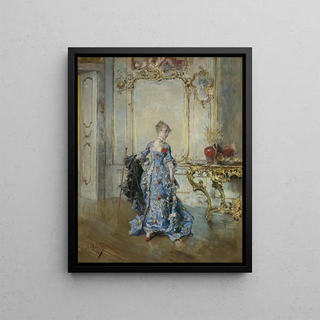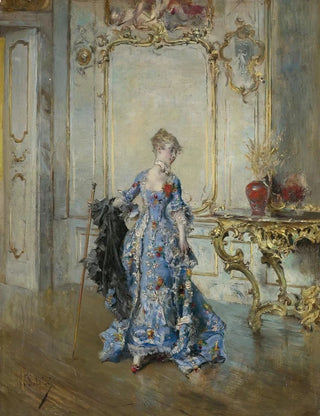Art print | The Last Look in the Mirror - Giovanni Boldini


View from behind

Frame (optional)
In the fascinating world of art, some works stand out for their ability to capture fleeting moments and deep emotions. "The Last Look in the Mirror" by Giovanni Boldini is one of those iconic pieces that transcends time and space. This artwork, created at the end of the 19th century, evokes not only the beauty and grace of a woman in full contemplation but also reveals the subtleties of an era marked by social and artistic changes. Boldini, master of the portrait, manages to breathe vibrant life into his subjects, and this canvas is a perfect example, offering a captivating glimpse of the elegance of the Belle Époque.
Style and uniqueness of the artwork
Giovanni Boldini's style is immediately recognizable, thanks to his fluid and dynamic painting technique. In "The Last Look in the Mirror," he uses bold brushstrokes and shimmering colors that give the scene a sense of movement. The woman depicted, dressed in a sumptuous gown, appears suspended in time, lost in her thoughts while gazing at herself in the mirror. Boldini excels in capturing light and reflections, creating an almost ethereal atmosphere. The artwork is not limited to a simple portrait; it tells a story, that of a woman who is both strong and vulnerable, symbolizing an era when femininity and independence began to assert themselves. The use of mirrors, recurring motifs in the artist's work, adds an extra dimension to the composition, inviting the viewer to reflect on the relationship between appearance and reality.
The artist and his influence
Giovanni Boldini, born in Italy and having built his career in Paris, is often associated with the Impressionist movement, although he developed a unique style of his own. His talent for portraiture attracted many personalities of his time, from aristocrats to artists. Boldini was able to capture not only the physical appearance of his subjects but also their essence, their character. His influence is palpable in the art world, inspiring generations of artists to explore the complexity of identity and human emotion through portraiture.

Matte finish

View from behind

Frame (optional)
In the fascinating world of art, some works stand out for their ability to capture fleeting moments and deep emotions. "The Last Look in the Mirror" by Giovanni Boldini is one of those iconic pieces that transcends time and space. This artwork, created at the end of the 19th century, evokes not only the beauty and grace of a woman in full contemplation but also reveals the subtleties of an era marked by social and artistic changes. Boldini, master of the portrait, manages to breathe vibrant life into his subjects, and this canvas is a perfect example, offering a captivating glimpse of the elegance of the Belle Époque.
Style and uniqueness of the artwork
Giovanni Boldini's style is immediately recognizable, thanks to his fluid and dynamic painting technique. In "The Last Look in the Mirror," he uses bold brushstrokes and shimmering colors that give the scene a sense of movement. The woman depicted, dressed in a sumptuous gown, appears suspended in time, lost in her thoughts while gazing at herself in the mirror. Boldini excels in capturing light and reflections, creating an almost ethereal atmosphere. The artwork is not limited to a simple portrait; it tells a story, that of a woman who is both strong and vulnerable, symbolizing an era when femininity and independence began to assert themselves. The use of mirrors, recurring motifs in the artist's work, adds an extra dimension to the composition, inviting the viewer to reflect on the relationship between appearance and reality.
The artist and his influence
Giovanni Boldini, born in Italy and having built his career in Paris, is often associated with the Impressionist movement, although he developed a unique style of his own. His talent for portraiture attracted many personalities of his time, from aristocrats to artists. Boldini was able to capture not only the physical appearance of his subjects but also their essence, their character. His influence is palpable in the art world, inspiring generations of artists to explore the complexity of identity and human emotion through portraiture.






